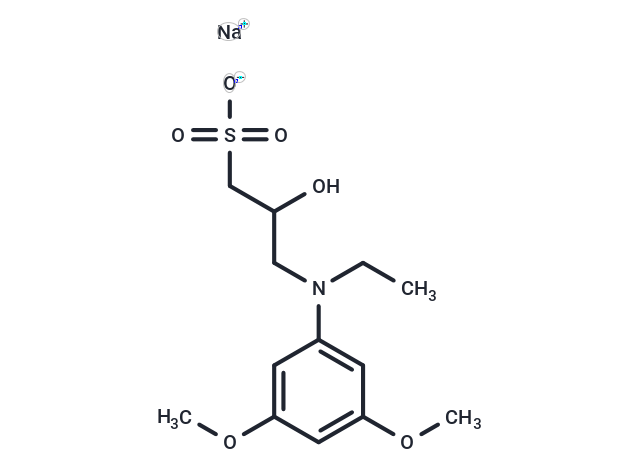Shopping Cart
Remove All Your shopping cart is currently empty
Your shopping cart is currently empty
DAOS (Sodium 3-((3,5-dimethoxyphenyl)(ethyl)amino)-2-hydroxypropane-1-sulfonate),Trinder's reagent, is a new type of highly water-soluble aniline derivative. It is widely used in diagnostic tests and biochemical tests.

| Pack Size | Price | USA Warehouse | Global Warehouse | Quantity |
|---|---|---|---|---|
| 50 mg | $29 | In Stock | In Stock | |
| 1 mL x 10 mM (in DMSO) | $29 | In Stock | In Stock |
| Description | DAOS (Sodium 3-((3,5-dimethoxyphenyl)(ethyl)amino)-2-hydroxypropane-1-sulfonate),Trinder's reagent, is a new type of highly water-soluble aniline derivative. It is widely used in diagnostic tests and biochemical tests. |
| In vitro | Instructions 1. Solvent Selection DAOS is a water-soluble compound that can usually be dissolved directly in water. For cases with poor solubility, if you need to accelerate dissolution, you can use a small amount of alcohol solvent (such as ethanol) mixed with water. 2. Sample Preparation DAOS is mainly used to detect peroxidase activity, and common applications include catalase or peroxidase reaction enzyme labeling systems. The sample is usually a solution containing the target enzyme (such as HRP) or peroxide. The concentration of the target enzyme that may be contained in the sample should be diluted as needed. 3. Reaction Conditions a. Reaction buffer: Select a suitable buffer (such as phosphate buffer in the pH range of 5–7) to maintain optimal enzyme activity and DAOS stability. b. Add DAOS: Add an appropriate amount of DAOS solution (usually 0.1–1 mM) to the sample. c. Reaction temperature and time: The reaction temperature is usually room temperature to 37°C. The reaction time depends on the activity of the enzyme in the sample and is usually between 10 minutes and 1 hour. d. Hydrogen peroxide (H₂O₂) is usually added as an oxidant to start the reaction. e. Color change: After the reaction, the product is brown or dark in color and can be quantitatively detected by colorimetry (such as UV-Vis spectrophotometer). 4. Product separation and purification The product after the reaction can be purified by solvent extraction or chromatography. If the product is water-soluble, impurities can be removed by centrifugation. 5. Detection and characterization UV-Vis spectrophotometry: The brown product produced by DAOS can be detected in the range of 450–490 nm. Colorimetry: By observing the color change in the reaction solution, the concentration of the target substance can be qualitatively or quantitatively analyzed. Precautions a. Storage conditions: DAOS should be stored in a dry, cool place away from light and moisture. Avoid contact with strong oxidants to prevent decomposition. b. Reaction optimization: Adjust the concentration of DAOS solution and reaction conditions according to the concentration and activity of the enzyme in the sample. c. Reaction termination: Too long a reaction time may cause the product to over-react, thus affecting the accuracy of the results. The reaction should be stopped in time. |
| Synonyms | Sodium 3-((3,5-dimethoxyphenyl)(ethyl)amino)-2-hydroxypropane-1-sulfonate |
| Molecular Weight | 341.36 |
| Formula | C13H20NNaO6S |
| Cas No. | 83777-30-4 |
| Smiles | [Na+].CCN(CC(O)CS([O-])(=O)=O)c1cc(OC)cc(OC)c1 |
| Relative Density. | no data available |
| Color | White |
| Appearance | Solid |
| Storage | keep away from direct sunlight | Powder: -20°C for 3 years | In solvent: -80°C for 1 year | Shipping with blue ice/Shipping at ambient temperature. | |||||||||||||||||||||||||||||||||||
| Solubility Information | DMSO: 65 mg/mL (190.41 mM), Sonication is recommended. | |||||||||||||||||||||||||||||||||||
| In Vivo Formulation | 10% DMSO+40% PEG300+5% Tween-80+45% Saline: 2.5 mg/mL (7.32 mM), Sonication is recommeded. Please add the solvents sequentially, clarifying the solution as much as possible before adding the next one. Dissolve by heating and/or sonication if necessary. Working solution is recommended to be prepared and used immediately. The formulation provided above is for reference purposes only. In vivo formulations may vary and should be modified based on specific experimental conditions. | |||||||||||||||||||||||||||||||||||
Solution Preparation Table | ||||||||||||||||||||||||||||||||||||
DMSO
| ||||||||||||||||||||||||||||||||||||
| Size | Quantity | Unit Price | Amount | Operation |
|---|

Copyright © 2015-2025 TargetMol Chemicals Inc. All Rights Reserved.